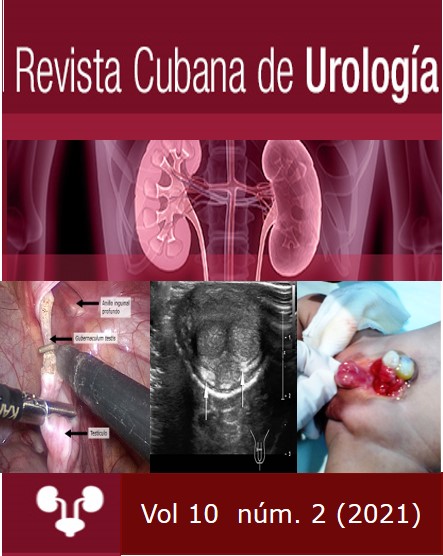Results of Extracorporeal Lithotripsy in Patients with Renal Lithiasis
Keywords:
próstata, hiperplasia prostática, prostatectomía, procederes quirúrgicos robotizados, laparoscopía, embolización terapéutica.Abstract
Introduction: Renal lithiasis is a public health problem with difficult solution. International Urology societies recommend the use of extracorporeal lithotripsy with shock waves as the first line in the management of lithiasis smaller than 2 cm in medium, upper calyxes and renal pelvis.
Objective: Show the results of extracorporeal lithotripsy in patients with renal lithiasis.
Methods: A prospective longitudinal study of a descriptive nature was carried out in 62 patients with renal lithiasis treated by extracorporeal lithotripsy from 2017 to 2020 at "Dr. Carlos J. Finlay" Central Military Hospital. The incidence rate of the physical-chemical composition of lithiasis on fragmentation was estimated in a binary logistic regression model, considering p < 0.05.
Results: The average age was 39.8 years, predominantly in the male sex. The most common metabolic disorder was hyperoxaluria and a good fragmentation prevailed. The composition of calcium oxalate predominated, more than 90% of patients were free of lithiasis and the most common complications were grade I and II according to the Clavein-Dindo classification. Calcium oxalate and phosphate were risk factors for poor fragmentation in patients with persistence of post-lithotric lithiasis.
Conclusions: Extracorporeal shockwave lithotripsy is an effective alternative in patients with nephrolithiasis. A low complication rate is equal as long as the patient selection criteria and pre-lithiasis and post-lithotric care are correctly applied.
Downloads
References
2. Wroclawski ML, Carneiro A, Alves Tristão R, Sakuramoto PK, Merched Youssef JD, Lopes Neto AC, et al. Giant prostatic hyperplasia: report of a previously asymptomatic man presenting with gross haematuria and hypovolemic shock. Einstein. 2015 [acceso 12/12/2020];13(3):420-2. Disponible en: https://www.ncbi.nlm.nih.gov/pmc/articles/PMC4943789/pdf/1679-4508-eins-13-3-0420.pdf
3. Anglickis M, Platkevičius G, Stulpinas R, Miklyčiūtė L, Anglickienė G, Keina V, et al. Giant prostatic hyperplasia and its causes. Acta Med Lituanica. 2019 [acceso 12/12/2020];26(4):237-43. Disponible en: https://www.researchgate.net/publication/340639521_Giant_prostatic_hyperplasia_and_its_causes
4. Aghamir SMK, Khatami F, Rahini MR, Guitynavard F. Giant bening prostatic hyperplasia: A case report. Urol Case Rep. 2020 [acceso 12/12/2020];(28):101051. Disponible en: https://www.ncbi.nlm.nih.gov/pmc/articles/PMC6833462/pdf/main.pdf
5. Ojewola RW, Tijani KH, Fatuga AL, Onyeze CI, Okeke CJ. Management of Giant prostatic enlargement: Case report and review of the literature. Niger Postgrad Med J. 2020 [acceso 12/12/2020];27:242-7. Disponible en: https://www.npmj.org/temp/NigerPostgradMedJ273242-6541395_181013.pdf
6. Baños Hernández I, Román Graverán JF, de Armas Ampudia I. Hiperplasia prostática gigante y adenocarcinoma prostático que se presenta como una tumoración abdominal. Rev Cub Urol. 2017 [acceso 12/12/2020];(2):127-30. Disponible en:
http://www.revurologia.sld.cu/index.php/rcu/article/view/317/339
7. Carbonara U, Osardu RK, Cisu TI, Balthazar A, Crosserosa F, Autorino R. Robot- assisted simple prostatectomy for Giant bening prostatic hyperplasia. Cent European J Urol. 2020 [acceso 12/12/2020]; 73:383-384. Disponible en: https://www.ncbi.nlm.nih.gov/pmc/articles/PMC7587478/pdf/CEJU-73-0207.pdf
8. Maliakal J, Mousa EE, Menon V. Giant prostatic hyperplasia. Sultan Qaboos Univ Med J. 2014 [acceso 12/12/2020];(2):e253-e255. Disponible en: https://www.ncbi.nlm.nih.gov/pmc/articles/PMC3997546/pdf/squmj1402-e253-256.pdf
9. Zeng QS, Zhao YB, Wang BQ, Ying M, Hu WL. Minimally invasive simple prostatectomy for a case of giant bening prostatic hyperplasia. Asian J Androl. 2017 [acceso 12/12/2020];19:717-8. Disponible en: https://www.ncbi.nlm.nih.gov/pmc/articles/PMC4943789/pdf/1679-4508-eins-13-3-0420.pdf
10. Somwaru AS, Metting S, Flinsnik LM, Nellamattathil MG, Sharma A, Katabathina VS. Prostate artery embolization has long term efficacy for treatment of severe lower urinary tract symptoms from giant prostatic hyperplasia. BMC Urol. 2020 [acceso 12/12/2020];20:153-60. Disponible en: https://bmcurol.biomedcentral.com/articles/10.1186/s12894-020-00726-
Downloads
Published
How to Cite
Issue
Section
License
Aquellos autores/as que tengan publicaciones con esta revista, aceptan los términos siguientes:
- Los autores/as conservarán sus derechos de autor y garantizarán a la revista el derecho de primera publicación de su obra, el cual estará simultáneamente sujeto a la Licencia de Creative Commons Reconocimiento-NoComercial 4.0 Internacional que permite a terceros compartir la obra siempre que se indique su autor y su primera publicación esta revista.
- Los autores/as podrán adoptar otros acuerdos de licencia no exclusiva de distribución de la versión de la obra publicada (p. ej.: depositarla en un archivo telemático institucional o publicarla en un volumen monográfico) siempre que se indique la publicación inicial en esta revista.
- Se permite y recomienda a los autores/as difundir su obra a través de Internet (p. ej.: en archivos telemáticos institucionales o en su página web) antes y durante el proceso de envío, lo cual puede producir intercambios interesantes y aumentar las citas de la obra publicada. (Véase El efecto del acceso abierto).





